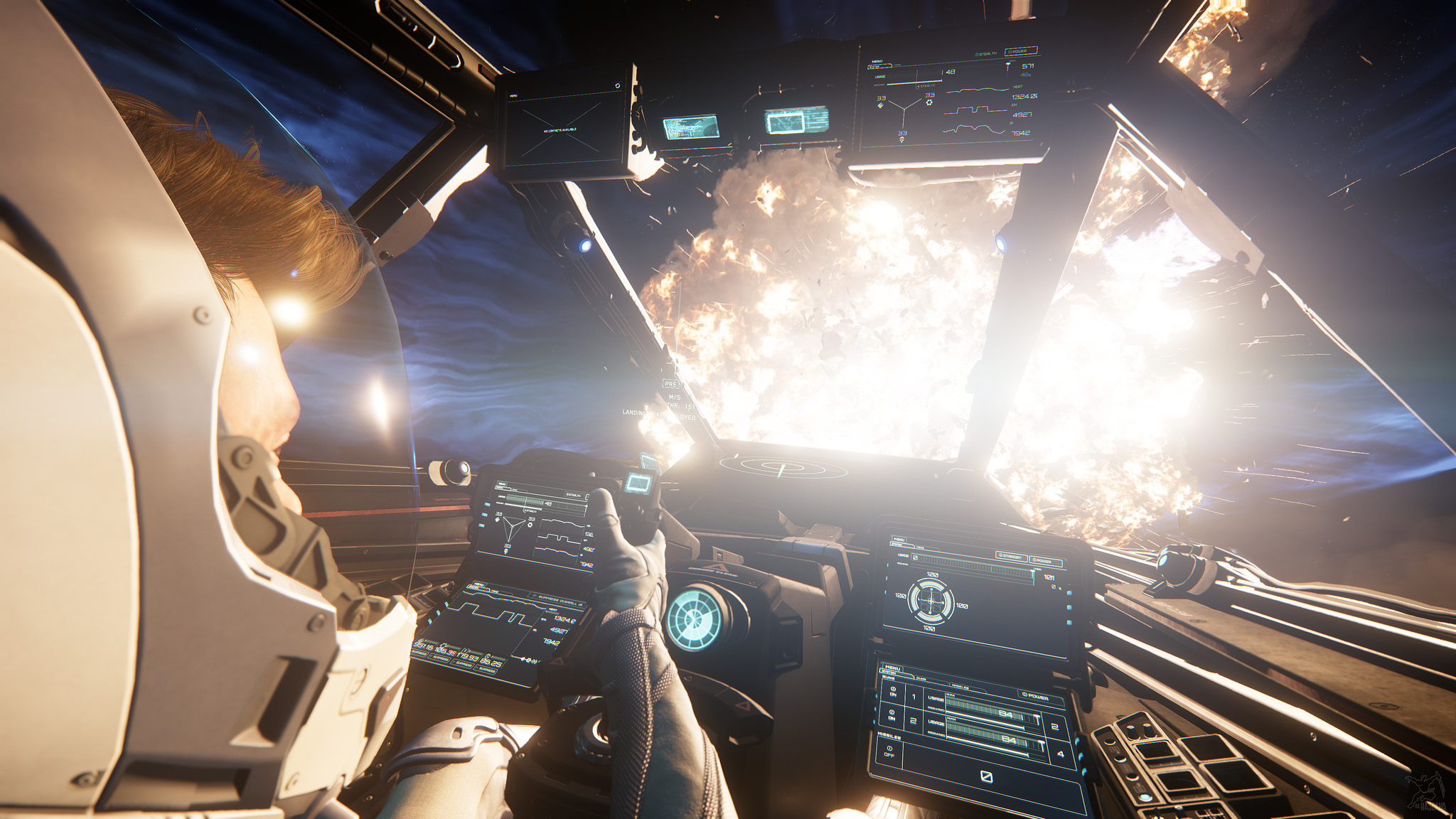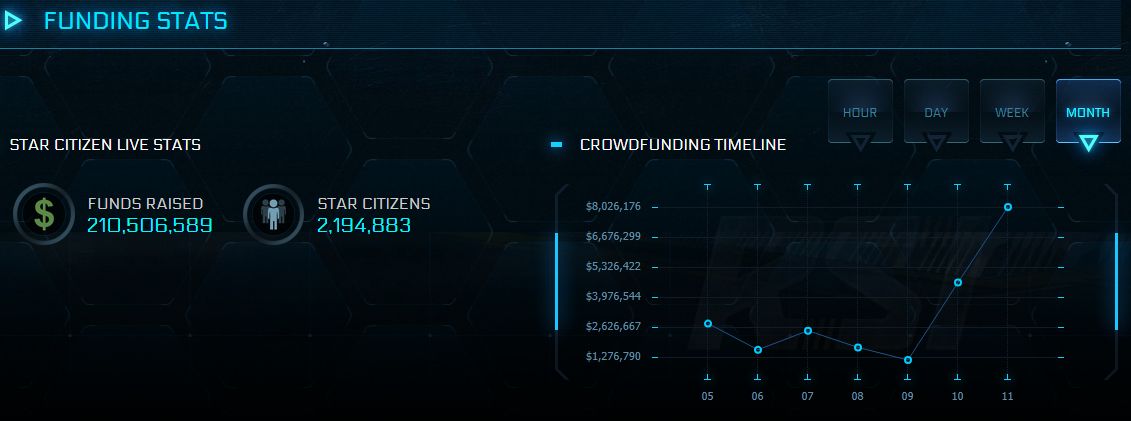How Star Citizen raised $7 million in seven days
Discounted space ships pulled in millions of dollars, but Star Citizen is still, first and foremost, selling a dream.

It's hard to imagine $200 million. That's the amount Star Citizen's crowdfunding total hit on November 23, and it's more than any other crowdfunded videogame has ever raised—number two on the list is Shroud of the Avatar, coming in at just under $13 million. That's a bit of a gap.
But then, $200 million was also the budget of Star Wars: The Old Republic (minus marketing). It's slightly less than the reported budget of Grand Theft Auto 5. Videogames cost a lot to make, especially online multiplayer games made by multiple studios around the world.
People paying thousands for Star Citizen ships are as alien to me as the Kilrathi. But there are moments when I understand the appeal.
Star Citizen has not slowed down since crossing the $200 million line. In fact, the pace of fundraising has accelerated. Since hitting that milestone, Star Citizen has already raked in another $10M. It raised $7M of that money in a single week when a free-fly event, which allowed players to test out every spaceship currently in the game, overlapped with an anniversary sale.
On November 22 players spent $68,699 on Star Citizen. On November 23, the first day of its free-flight week and concurrent sale, the amount jumped to $234,245. And that was a low-earning day. For three days of the period it was clearing a million dollars per.
The prosaic answer to "how did Star Citizen raise seven million dollars in a single week" is "by having a sale." But that doesn't answer the actual question, which is this: Why are people still throwing money at this game, now six years after its initial Kickstarter campaign?

Car Citizen
I own a spaceship in Star Citizen. (It didn't cost anything, I got it in a graphics card giveaway.) It came with a "game package" which is what you need to play the parts of Star Citizen that are currently available. There's a dogfight mode, which also includes racing, an FPS mode I honestly have no interest in, a hangar to customize your ships in, and universe mode—which is where you explore a space station full of other players, get a job, and cruise off to deliver cargo, shoot bad guys, or investigate an abandoned station. It's minimal and glitchy, but there's definitely a game here.
Away from official forums and the in-game chat, it's hard to find anything but negativity about Star Citizen. On the inside of the community, it's all hope and smiles.
After playing detective on that abandoned station, I exited to find my ship had floated 1.8km away. At first I assumed someone was playing a joke, but someone in global chat explained to me it's a known bug. Sometimes ships that aren't in a hangar just drift. The next job I took was a delivery, which ended with me trying to get the fussy controls to let me place a fluoride crate in a drop-off chute for several long minutes.
The biggest gaming news, reviews and hardware deals
Keep up to date with the most important stories and the best deals, as picked by the PC Gamer team.
It's hard to go any amount of time without annoyances like these. The glitchy universe mode isn't what's selling players on Star Citizen.
Each day of the sale a different set of spaceships was discounted, and on the day sales crossed a million dollars for the first time in the $7 million week, it was the Aegis brand. Military-style craft, the Aegis ships look like sleek modern Air Force jets—one of them's a straight-up stealth bomber—and while you could pay $66 for an Aegis Avenger Stalker today (if you're in the market for a cute runabout fighter), you could also preorder the in-production Idris-P frigate, which was made available in limited quantities for $1,250.

I'm the kind of person who finds it baffling when people drop $200 to pre-order a game because it comes with some swag, so people paying thousands (even tens of thousands) for Star Citizen ships are as alien to me as the Kilrathi. But there are moments when I understand the appeal.
People post pictures of their first ship with all the pride of new homeowners willing to overlook any flaw. "I really love the Aurora. It feels like a real spaceship and has loads of character," writes Redditor BrokkelPiloot. They go into raptures about their corridors. "The kind of ship that makes you want to invest in a flame thrower," writes Redditor MetaParser.
In this thread about what people bought last year, there's a discussion comparing the Freelancer to the Cutlass Black as involved as any barstool conversation about cars. Most come down on the side of the Cutlass, but user shiroboi just bought a 'Lancer because "they had it free on a free fly for a week and I absolutely loved it so ended up getting one. No regrets, it's a really great all around ship."
Something that's ramped up over the course of Star Citizen's development, especially around events like CitizenCon and this anniversary sale, are a blitz of YouTube videos. Some are commercials for new ships which double ads aimed at players and in-universe ads you can imagine your character watching, daydreaming about flying a Drake Cutlass Black. The videos are slick as hell, each manufacturer expressing distinct personality through no-nonsense truck commercials or music videos about rockstar pilots.
In addition to those ads, there are video series like the roundtables highlighting each brand of ship, with members of the team discussing their design, effectiveness, and placement in the history of Star Citizen's imagined future. Watching videos intercut with ships spinning in 3D I get the same feeling I had playing Wing Commander: Privateer, staring at the Centurion as I saved up the credits. I get it. Spaceships are cool.
Members only
Star Citizen is selling more than just imaginary spaceships, though. Outside the subreddit, away from official forums and the in-game chat, it's hard to find anything but negativity about Star Citizen. On the inside of the community, it's all hope and smiles. During this year's CitizenCon there was a video more than an hour long showing new parts of the universe mode gameplay, where each AI glitch and dodgy animation was greeted with indulgent laughter, like parents watching a toddler stumble. It's a generosity a million miles from the people calling it "Scam Citizen."
On the inside there's an exclusive golf club atmosphere, weirdly genial for a game about shootouts in space, where anyone losing it in the chat is tutted at and told to take it elsewhere. It's oddly pleasant to be in, which videogame communities often aren't, because to get in you have to buy in—not just forking over for a game package and a ship, but buying into the dream Star Citizen represents. You wouldn't be here if you didn't. This is what people pay, and keep paying, to experience.
The kind of complaints that dominate the frontpage of most videogame subreddits are ignored or dismissed. Instead players commiserate with each other about being infected by the ship buyer virus, enabling each other with comments like, "Embrace the madness! Everyone has their hobbies, some spend thousands a year or more on them, mine just happens to be virtual spaceships."
The last time I saw someone get mildly upset it was because some ships were being sold in limited numbers rather than rolled out permanently for everyone to buy. "Wouldn't they make so much more money if they sold ships continuously as they are produced?" asked the concerned Citren0.

Star Citizen's developers know, despite skepticism targeting the game from the outside, that there's immense power in the community they have. Chris Roberts knows that community is buying a dream when it spends $7 million on spaceships in seven days—it's right there in the letter he wrote when Star Citizen hit the $200 million milestone.
"How Star Citizen is made, in public, warts and all, is part of what makes it special. It should be a no-brainer to cheer on a grassroots funded game that is literally shooting for the stars. No one is attempting to do what we are doing, in the manner we are doing it, nor being as open about as we are. Different and new can be scary, but it can also be exhilarating and rewarding. These uncharted frontiers of game development and funding, mirror the draw of the game itself; the lure of distant planets to explore, realized to an unprecedented detail and scale… Thank you, each and every one of you, for believing in the vision, supporting its development with unwavering commitment and making gaming history."
In Command & Conquer: Red Alert 3, Tim Curry declares he's escaping to the one place that hasn't been corrupted by capitalism: Space. Sometimes, Star Citizen feels like a very expensive way of proving him wrong.

Jody's first computer was a Commodore 64, so he remembers having to use a code wheel to play Pool of Radiance. A former music journalist who interviewed everyone from Giorgio Moroder to Trent Reznor, Jody also co-hosted Australia's first radio show about videogames, Zed Games. He's written for Rock Paper Shotgun, The Big Issue, GamesRadar, Zam, Glixel, Five Out of Ten Magazine, and Playboy.com, whose cheques with the bunny logo made for fun conversations at the bank. Jody's first article for PC Gamer was about the audio of Alien Isolation, published in 2015, and since then he's written about why Silent Hill belongs on PC, why Recettear: An Item Shop's Tale is the best fantasy shopkeeper tycoon game, and how weird Lost Ark can get. Jody edited PC Gamer Indie from 2017 to 2018, and he eventually lived up to his promise to play every Warhammer videogame.

